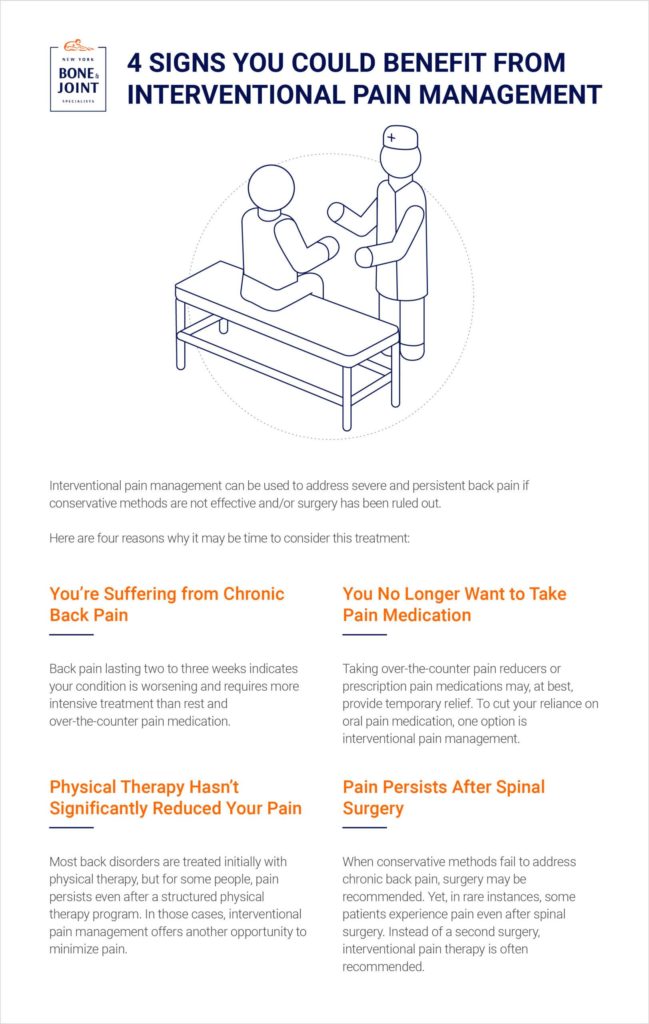If you’re suffering from chronic back pain, interventional pain management could help you find relief.
About 16 million Americans have chronic back pain, which can get in the way of living a full, active life. Thankfully, an entire medical specialty has evolved to offer patients relief. Interventional pain management precisely targets the nerves and joints in your spine that are causing pain and discomfort.
Interventional pain management treats a wide spectrum of spinal disorders, including, but not limited to, herniated discs, sciatica, spinal stenosis, pinched nerves, facet joint pain, and sacroiliac syndrome. What makes interventional pain management an effective alternative to other pain management methods is its ability to accurately identify the source of your back pain — and then prescribe treatments to wipe it out.
But first, you and your orthopedist must decide if you’re a candidate for interventional pain management.
Is it Time for Interventional Pain Management?
Interventional pain management may be used to address severe and persistent spinal pain if conservative methods are not effective and/or surgery has been ruled out. Here are four reasons why it may be time to consider this treatment:
- You’re Suffering from Chronic Back Pain. Back pain lasting two to three weeks indicates your condition is worsening and requires more intensive treatment than rest and over-the-counter pain medication. If the pain has gotten so severe you are unable to work or perform everyday activities, you may need interventional pain therapy.
- You No Longer Want to Take Pain Medication. Taking over-the-counter pain reducers or prescription pain medications may, at best, provide temporary relief. To cut your reliance on oral pain medication, one option is interventional pain management. Depending upon the specific treatment, the pain-reducing effect can last several months.
- Physical Therapy Hasn’t Significantly Reduced Your Pain. Most back disorders are treated initially with physical therapy. Exercises designed to loosen joints can lessen pain and restore full range of motion. But for some people, pain persists even after a structured physical therapy program. In those cases, interventional pain management offers another opportunity to minimize pain.
- Pain Persists After Spinal Surgery. When conservative methods fail to address chronic back pain, surgery may be recommended. Yet, in rare instances, some patients experience pain even after spinal surgery. Residual pain following surgery may be due to scar tissue, previous nerve damage, or new pain that develops in the muscles or tissues not related to the reason for the operation. Or, it could be a recurrence of the original disorder. Instead of a second surgery, interventional pain therapy is often recommended.

Types of Interventional Pain Management Treatments
There are a number of interventional pain management therapies used today for chronic back pain, but the most common treatments involve an injection of either an anesthetic or steroid to block pain signals from reaching the brain. This medicine is injected into the spine, the sacroiliac joints in the hip, the facet joints (the joints on each side of the spine), or the specific nerve that is causing pain.
To pinpoint the exact source of back pain, your doctor will order imaging tests (X-rays and MRIs) and record your health history. He or she will also want to know your activity level, when the pain started, and whether you’re taking any medications. The first injection also serves as a diagnostic tool. If it’s successful in diminishing pain, then the treatment has found the exact pain point.
The doctors and physical therapists at New York Bone & Joint Specialists are experts in treating back pain through physical therapy, surgery, or interventional pain management. Our specialists can help diagnose the source of your pain and then recommend a personalized treatment plan. Contact us today to set up an appointment.




